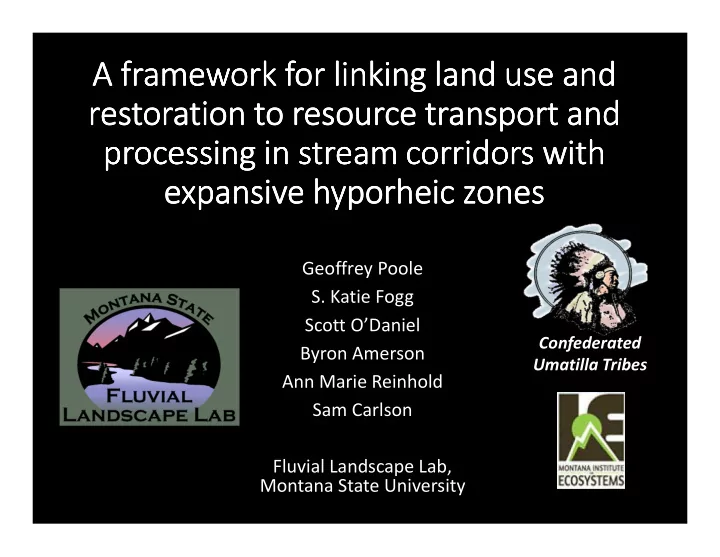

A framework for linking land use and A framework for linking land use and A framework for linking land use and A framework for linking land use and restoration to resource transport and restoration to resource transport and restoration to resource transport and restoration to resource transport and processing in stream corridors with processing in stream corridors with processing in stream corridors with processing in stream corridors with expansive hyporheic zones expansive hyporheic zones expansive hyporheic zones expansive hyporheic zones Geoffrey Poole S. Katie Fogg Scott O’Daniel Confederated Byron Amerson Umatilla Tribes Ann Marie Reinhold Sam Carlson Fluvial Landscape Lab, Montana State University
Meacham Creek, Oregon, USA 5 years post-restoration Immediate post-restoration Pre-restoration
Umatilla River, OR Poole et al. Submitted. River Research and Applications.
Poole et al. 2008. River Research and Applications.
� � � � � Stream channel ��� � �� � � � � � � � � minutes � hours p(t) days weeks n m t months t k t k+1 storage = flow x t ∝ t k+1 x t ∝ ∝ ∝ ∝ ∝ ∝ ∝ t k+2 Poole et al. In Preparation.
k = -1.6 1 minute 1 hour 1 day 1 week 1 month
Nyack Floodplain Middle Fork Flathead River, MT Helton et al. 2012. J. Geophysical Research.
k = -1.6 1 minute 1 hour 1 day 1 week 1 month
Meacham Creek, Oregon, USA k ≈ -1.6 k ≈ -1.4 Flow Direction
Saturated thickness of alluvial aquifer 3m 2m 7/1/2011 7/26/2011 8/30/2011 Hyporheic zone increased from ~2m to ~3m in thickness
Pre-restoration Post-restoration k ≈ -1.4 k ≈ -1.6 1 minute 1 minute 1 hour 1 hour 1 day 1 day 1 week 1 week 1 month 1 month
Heat Model Shortwave Longwave Sensible Latent • Atmospheric heat exchange. • Advection of heat with water Stream channel among hyporheic “bins” and stream channel. • Storage of heat in gravel and water within each bin based on bin volume, specific heat of water and sediment, and aquifer porosity.
Instantaneous rate of channel water temperature change (degC/hr)
Instantaneous rate of channel water temperature change (degC/hr)
Conclusion • Hydrology governs the transport and dynamics of energy and solutes in linked riverine/hyporheic hydro-systems. Geomorphology governs the hydrology.
Conclusions • The parsimony of hydrologic conceptual models enhances or limits our ability to understand (and predict?) physical and biotic responses to land use change and restoration efforts. Stream channel minutes hours days weeks months
Nyack Floodplain Middle Fork Flathead River, MT Helton et al. 2012. J. Geophysical Research.
Parting thoughts • For hillslopes, “flow accumulation” and “upslope accumulated area” are the dominant hydrologic paradigms. • How do the hydrologic assumptions embedded in these concepts facilitate and limit our understanding of transport/processing? • How would our understanding change by incorporating residence time distributions or other key aspects of “hydrologic reality?”
OK, let’s review and consider where to go from here. • Again, this comes mostly from Geoff Poole at Montana State University.
Water flow Meacham Creek Restoration Site, OR Stream channel minutes hours Hyporheic Zone partitioned by days water age weeks months
� � − � � Parameterization Parameterization Parameterization Parameterization ��� � � � � � − � � � � area = 1 p(t) CDF( n ) = 1 n m p(>t) t n m t � ��� − � ��� − (� − �)� � � + 1 ��� � = (� ��� − � ��� ) − (� − �)� � � + 1
Parameterization Parameterization Parameterization Parameterization Stream channel minutes hours days weeks months CDF = p(>t) n m t
Bin Statistics 1-5 mins 5-13 mins 13 - 28 mins 28 - 60 mins Using estimates of: 1 - 2 hrs • k 2 - 4 hrs 4 - 8 hrs • Size of hyporheic 8 - 16 hrs 16 - 32 hrs zone 1.4 – 2.8 days 2.8 – 5.6 days • porosity 5.6 – 11.2 days 1.6 – 3.2 weeks 3.2 – 6.4 weeks 1.5 – 3.0 months
Bin Statistics
Bin Statistics
Bin Statistics
Future Directions – Hydrologic controls on Biogeochemistry + + 2O 2 - + H 2 O + 2H + NH 4 NO 3 1 N N 1 3 O H 4 2 H 1 O O 4 2 H
Biogeochemistry that we must learn to model accurately. • Methane oxidation • Aerobic heterotrophy • Denitrification • Sulfide oxidation • Nitrification • Sulfate Reduction • Methanogenesis • Biotic Assimilation of: HS, NH4, SO4, DOM, NO3, CH4, CO2
Recommend
More recommend